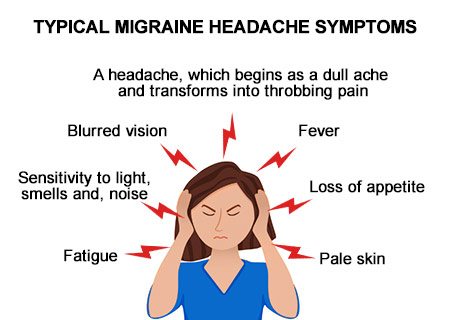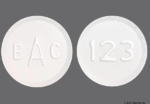Migraine is a common neurological condition that affects millions of people from all ages, nationalities and gender. Like any other disease, its presence is manifested by symptoms felt by the sufferer and whose existence allows physicians to make a diagnosis.

What are migraines?
Migraines are a recurring type of headache. They cause moderate to severe pain that is throbbing or pulsing. The pain is often on one side of your head. You may also have other symptoms, such as nausea and weakness. You may be sensitive to light and sound.
What causes migraines?
Researchers believe that migraine has a genetic cause. There are also a number of factors that can trigger a migraine. These factors vary from person to person, and they include
- Stress
- Anxiety
- Hormonal changes in women
- Bright or flashing lights
- Loud noises
- Strong smells
- Medicines
- Too much or not enough sleep
- Sudden changes in weather or environment
- Overexertion (too much physical activity)
- Tobacco
- Caffeine or caffeine withdrawal
- Skipped meals
- Medication overuse (taking medicine for migraines too often)
Some people have found that certain foods or ingredients can trigger headaches, especially when they are combined with other triggers. These foods and ingredients include
- Alcohol
- Chocolate
- Aged cheeses
- Monosodium glutamate (MSG)
- Some fruits and nuts
- Fermented or pickled goods
- Yeast
- Cured or processed meats
Who is at risk for migraines?
About 12% of Americans get migraines. They can affect anyone, but you are more likely to have them if you
- Are a woman. Women are three times more likely than men to get migraines.
- Have a family history of migraines. Most people with migraines have family members who have migraines.
- Have other medical conditions, such as depression, anxiety, bipolar disorder, sleep disorders, and epilepsy.
What are the symptoms of migraines?
The most common migraine symptom and the most recognizable as well, is the headache. Although it is not present in the rarer forms of the disease, it is one evident sign of migraine. The headache that accompanies a migraine is not the kind that gives a dull ache. The pain felt by migraineurs is the intense, throbbing kind which sometimes necessitates complete rest and disrupts normal daily functions. However , a headache is not the only indicator that signals a migraine. Depending on the migraine attack, a host of other symptoms arise as well. Analyzing them helps the medical practitioner in determining what type of migraine the patient is suffering from and in prescribing the appropriate medications.
There are four different phases of migraines. You may not always go through every phase each time you have a migraine.
- Prodome. This phase starts up to 24 hours before you get the migraine. You have early signs and symptoms, such as food cravings, unexplained mood changes, uncontrollable yawning, fluid retention, and increased urination.
- Aura. If you have this phase, you might see flashing or bright lights or zig-zag lines. You may have muscle weakness or feel like you are being touched or grabbed. An aura can happen just before or during a migraine.
- Headache. A migraine usually starts gradually and then becomes more severe. It typically causes throbbing or pulsing pain, which is often on one side of your head. But sometimes you can have a migraine without a headache. Other migraine symptoms may include
- Increased sensitivity to light, noise, and odors
- Nausea and vomiting
- Worsened pain when you move, cough, or sneeze
- Postdrome (following the headache). You may feel exhausted, weak, and confused after a migraine. This can last up to a day.
Migraines are more common in the morning; people often wake up with them. Some people have migraines at predictable times, such as before menstruation or on weekends following a stressful week of work.
An inventory of migraine symptoms could be quite lengthy due to the various types of the disease. A generalized list of these include: severe headache on one or both sides of the head, nausea, vomiting, weakness, vision disturbance, sensitivity to light and sound, pain over one eye, aura, blurred vision and temporary blind spots. When the migraine comes with aura, this gives rise to a whole new set of symptoms that consists of: seeing flashing lights or zigzag lines, temporary blindness, speech difficulty, tingling and weakness in the limbs and face, confusion, giddiness and noise sensitivity. This does not mean the sufferer undergoes all the symptoms during the attack. Most likely, he will experience only a few. Symptoms also vary from person to person. Further, a migraine symptom could be felt days before the attack, during the prodrome stage. In these times, the migraineur has unexplained feelings of elation or intense energy, cravings for sweets, thirst, drowsiness or irritability and depression.
How are migraines diagnosed?
To make a diagnosis, your health care provider will
- Take your medical history
- Ask about your symptoms
- Do a physical and neurological exam
An important part of diagnosing migraines is to rule out other medical conditions which could be causing the symptoms. So you may also have blood tests, an MRI or CT scan, or other tests.
Diagnosing migraine is not an easy task for the physician. In order to make an accurate evaluation, he will need to have as much information as possible, obtained from the patient and from medical tests conducted. Observation and analysis of symptoms is very helpful in arriving at a diagnosis. By knowing what symptoms are experienced by the patient, the specialist will be able to tell what type of migraine it is and what treatments are to be administered. During consultation, the patient will be required to describe the duration and frequency of his headaches and how intense they are, where pain is located, presence of associated symptoms and behavior during a headache. Since other illnesses also exhibit similar sings to migraine, these have to be ruled out. A case in point is the fact that people with sever sinusitis also experience double vision and vision loss.
Experiencing migraine, however mild, is not a pleasant event. But the sufferer can put this to good use by being observant and recording what he is going through. The complexity of migraine and the difficulty in diagnosing it means that no detail is insignificant. Thus, if the patient is to take an active role in the management of his disease, he needs to be vigilant of every single migraine symptom.
How are migraines treated?
There is no cure for migraines. Treatment focuses on relieving symptoms and preventing additional attacks.
There are different types of medicines to relieve symptoms. They include triptan drugs, ergotamine drugs, and pain relievers. The sooner you take the medicine, the more effective it is.
There are also other things you can do to feel better:
- Resting with your eyes closed in a quiet, darkened room
- Placing a cool cloth or ice pack on your forehead
- Drinking fluids
There are some lifestyle changes you can make to prevent migraines:
- Stress management strategies, such as exercise, relaxation techniques, and biofeedback, may reduce the number and severity of migraines. Biofeedback uses electronic devices to teach you to control certain body functions, such as your heartbeat, blood pressure, and muscle tension.
- Make a log of what seems to trigger your migraines. You can learn what you need to avoid, such as certain foods and medicines. It also help you figure out what you should do, such as establishing a consistent sleep schedule and eating regular meals.
- Hormone therapy may help some women whose migraines seem to be linked to their menstrual cycle
- If you have obesity, losing weight may also be helpful
If you have frequent or severe migraines, you may need to take medicines to prevent further attacks. Talk with your health care provider about which drug would be right for you.
Certain natural treatments, such as riboflavin (vitamin B2) and coenzyme Q10, may help prevent migraines. If your magnesium level is low, you can try taking magnesium. There is also an herb, butterbur, which some people take to prevent migraines. But butterbur may not be safe for long-term use. Always check with your health care provider before taking any supplements.
Why is Fioricet used to treat migraine?
Fioricet is an older medication that used to frequently be prescribed to treat migraine symptoms. However, there is not enough evidence that shows it’s effective for migraine attacks, especially when compared to safer products.
Although Fioricet has been used for many years for migraine, it’s not approved for this use, and there are greater risks than benefits with this medication.
Fioricet may be an option if other migraine treatment options have not worked. Your doctor will just want to monitor you closely to avoid side effects.
It’s prescribed to help relieve immediate headache symptoms, but not to prevent migraine attacks.
How does Fioricet work to treat migraine?
Fioricet contains three different active ingredients which work together on tension headaches. The exact way Fioricet works to help relieve tension headache is not clear.
Butalbital is a barbiturate that helps with relaxation and anxiety, acetaminophen works as an analgesic for pain relief, and caffeine also helps with pain relief.
Pain Medications, Pain Relief, and Pain Management





